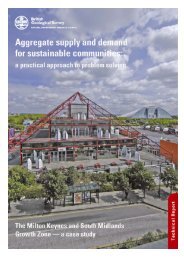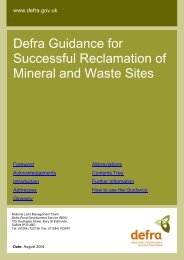creating environmental improvements through biodiversity
creating environmental improvements through biodiversity
creating environmental improvements through biodiversity
You also want an ePaper? Increase the reach of your titles
YUMPU automatically turns print PDFs into web optimized ePapers that Google loves.
Sustainable Aggregates Creating Environmental Improvements <strong>through</strong> Biodiversity<br />
Points out that site design often does not include specific, measurable biological aims<br />
States that a study on development of a site, looking at initial aims, would provide valuable information on<br />
the effectiveness of advice given in best practice guides<br />
Points out that the available guides are well researched and useful, but do not address ‘aerodrome<br />
safeguarding’ as a planning consideration<br />
States that aerodrome safeguarding should be taken into account at an early stage<br />
States that after-use of minerals sites has been increasingly considered with awareness of BAPs being raised<br />
in the UK by statutory and other conservation bodies<br />
States which species are considered to pose a more significant risk to aircraft – generally medium to large<br />
birds that form flocks<br />
Summarises each reference reviewed<br />
Lists key sources of technical information<br />
Points out that aerodromes often occupy the flat land of river valleys, which is similar to many sand and<br />
gravel extraction sites<br />
States that details on specific restorations are mostly within the non-scientific literature in a case study<br />
format<br />
Points out that restorations are generally not classified into ecologically meaningful categories, and that BAP<br />
habitats should be considered<br />
Summarises UK BAP targets for habitat creation<br />
States that ‘the UK BAP targets for habitat creation therefore favour woodland, heathland and grassland over<br />
wetland creation where possible’ and that ‘there is not even a target amount of wetland habitat specified’<br />
– clearly this refers to standing open water rather than wetland - it goes on to state that guidance is left<br />
open on amounts of standing open water created<br />
States that water bodies of varying size are the main wetland type found in the UK<br />
States that the study deals with some of the most interesting and simple relationships of bird populations<br />
with water bodies, and that more detailed study is needed<br />
Lists some important factors influencing waterfowl use of water bodies from the scientific literature,<br />
including: history, management, age, size, basin shape, water source, water quality, stability, depth, ratio of<br />
open water to vegetated areas, shore line slope and contour, ratio of shore length to open water, plant<br />
species diversity, nearest neighbouring water body, recreational disturbance, fish stocks, islands, pH, bed<br />
characteristics, soils<br />
States that there is limited long-term monitoring of bird populations on minerals sites<br />
Identifies the following gaps in knowledge:<br />
• Bird abundance and species diversity in relation to different mineral site restorations<br />
• Movements of different bird species on and between water bodies or within larger water body<br />
complexes – addressed in the associated bird movement study<br />
• Details of waterfowl and gull movements in this context, in a range of seasons and weather conditions,<br />
over a 24 hour cycle and at relevant scales<br />
Provides list of references<br />
Impacts (Actual):<br />
The study brought together information from a variety of sources, which will be useful as a reference for<br />
future work. It identified a knowledge gap on the relationships of bird populations with different types of<br />
water bodies, which the next stages of the study went on to address<br />
Impacts (Potential):<br />
90

















